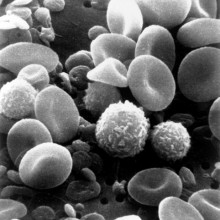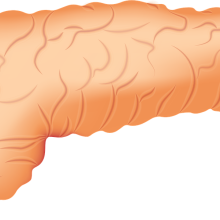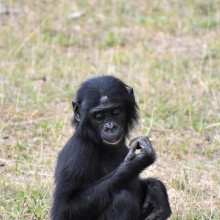Artificial platelets, and angry primates
This week on The Naked Scientists: Scientists invent artificial platelets to help clot blood; why it might be time to reappraise the peace-loving nature of bonobos; and why the Moon may have turned itself inside out in the past…
In this episode

00:55 - Artificial platelets to buy trauma victims vital time
Artificial platelets to buy trauma victims vital time
Ashley Brown, North Carolina State University
Around 1.5 million people die from catastrophic bleeding. A large number of these people have been involved in accidents and - because infusing blood - and specifically blood clotting products - outside of a medical setting is very difficult - they often die before they reach hospital. But now, scientists at North Carolina State University have developed a particle based on an artificial gel decorated like a christmas tree with proteins that give it the right functions to mimic the actions of platelets. These cells fragments in our blood are responsible for kick starting the clotting process; these artificial ones could buy people the time they need to get to urgent care. Ashley Brown is an author on the study...
Ashley - When someone receives platelets, such as after injury or when someone's having surgery or if they have chemotherapy, for example, patients will receive platelets that come from donors. However, platelets are in really short supply because they have to come from adult or human donors. They are always going to be limited in supply. They also have a really short shelf life. So platelets can be stored anywhere from seven days to a couple of weeks, but that's a really short shelf life. And so by making a synthetic platelet, we can get around some of those challenges of normal platelet donations. Additionally, by making a synthetic platelet, we have the ability to get around blood type matching as well as limitations in platelet transport and any potential issues that might come from infection.
Chris - When you say artificial platelets or sort of platelet mimics, are we talking about growing things in dishes that then turn into platelets or starting completely in a different direction, with artificial molecules that just do the same job as a platelet but are not natural tissue.
Ashley - We are not growing cells in a dish. We start out with a biomaterial. So this is what is known as a polymer, which we use to make a hydrogel network. We create a hydrogel that is the size of a nanoparticle and then we decorate it with what's known as an antibody fragment. And this allows us to mimic certain features of natural platelets such as the size, the shape, and the ability of natural platelets to target wound sites.
Chris - When you inject these, do they actually work like platelets, although they've got all those other features which are very attractive, will they actually promote blood coagulation where they should?
Ashley - Absolutely. So as you mentioned, the way that these work is that we inject them into the bloodstream and they are able to go straight to sites of injury. The way that they do that is because they're decorated with an antibody that specifically will interact with certain proteins that are at the wound site. And so what that means is when we inject our particles, they will just circulate in your bloodstream until they come into contact with an area where you have active bleeding and active clot formation. The particles then bind specifically to that area and begin to accumulate. They then work with the body's natural clotting system to enhance and speed up the clotting process.
Chris - Is there not a danger though, if you're putting something which has got this kind of power into the circulation, that it could tip the balance towards developing blood clots where you don't want them, things like your coronary arteries to cause a heart attack or your cerebral vessels and cause a stroke?
Ashley - Because of the way in which we've designed these particles, they go straight to those injury sites. We have, however, looked very extensively to look for that off-target clotting. And in the models that we've used so far, we have not seen any evidence of off-target clotting.
Chris - And when you put them in, if you've got you say a model, things like mice and rats and bigger animals and so on. If you put them into an animal and it has an injury akin to the kind of injury a human would expect to receive, platelets to treat, does it work? Does it actually save lives and prevent haemorrhage in those animals?
Ashley - Absolutely. So we've looked in multiple models and in mice, rats and large animal pore signs or pig models, we've seen that the particles are able to stop bleeding very rapidly and essentially yes, save the life of the animal and enhance healing over a period of several days. The specifics of those bleeding dynamics depend on the injury. The models that we have looked at have been with what's known as a traumatic liver injury. So this is a very major type of injury. In mice, we see that the bleeding stops within minutes in the porcine models, we also see bleeding stop on the order of minutes to tens of minutes, which is significantly better than what we see in saline only treatment groups. I'd also like to point out that we've compared these particles to natural platelets and we see that our particles actually perform even better than normal platelets, if we do a platelet to particle matching.
Chris - Obviously the problem doesn't stop as soon as you stop the blood clotting. You've then got a blood thrombus, a clot at the site of the injury, which naturally would break down over time as the tissue healed. So what happens to your particles in the long term? Do they break down as well?
Ashley - So they don't break down specifically. However, we have seen that they are safely tolerated by the body and any particles that don't go to the wound site are able to come out through the urine. And we've seen that after delivery of the particles. There's no adverse effects that we've observed to this point, even at really high doses of the particles. So they're well tolerated and they're able to be excreted through normal mechanisms.
Chris - What are the implications and the next steps then now you've got this proof of concept? Is the next step to go to clinical trials and try this in people?
Ashley - Absolutely. So currently we're working towards a few additional preclinical toxicology studies, which are required before moving into clinical trials. But then the next step after that would be moving into human clinical trials.

07:43 - Bluetooth pancreas to help people with type 1 diabetes
Bluetooth pancreas to help people with type 1 diabetes
Roman Hovorka, University of Cambridge
An artificial pancreas now approved by the National Institute for Clinical Excellence - NICE - is set to help tens of thousands of children and adults living with type one diabetes. The ground-breaking device monitors a person’s blood glucose, and automatically adjusts the amount of insulin given to them through a pump. It’s all done wirelessly through bluetooth. It was developed by Cambridge University’s Professor Roman Hovorka...
Roman - So what we are talking about is a system which can control glucose levels in people who have type one diabetes. So we have a sensor which reads glucose. It goes into the computer program interpreter, which analyses the data, and then it has a device which delivers the right amount of insulin to give.
Chris - How does it all work and wire together and operate?
Roman - So we live now in the 21st century. So all the communication is Bluetooth. The computer program can sit on your smartphone.
Chris - In essence, then, a sensor is tasting the tissue fluid to work out what your blood glucose is. It's telling the computer program running on the smartphone that level all the time. And the smartphone is then computing what level of insulin to tell the pump to inject. Why is that better than the way we used to do it where you would just prick a finger, test a blood sample, inject insulin?
Roman - The reason is because we are all different and, not only we are all different, we are all different all the time. And glucose levels in your body need to be well controlled to avoid long term complications or health consequences. And it relates to the problem with your feet, with your kidney, with your eyes, with your heart. And it is very difficult for people to do so without this automatic management. They can do it, but it doesn't generally burn themselves out. Like parents would be waking up four or five times a night every night to manage and to check glucose levels. This device can do it on its own.
Chris - Presumably you've now got data showing that people who use this system achieve better long-term control of their glucose levels and therefore we think are likely to have better health outcomes compared to the more traditional way of managing diabetes.
Roman - So we should not forget that before 1920, when insulin was discovered, people uniformly died. Since then, there was a gap between the life expectancies, which until recently was about 20 years with type one diabetes. So that gap is closing and it's closing because we have better management of glucose levels and this technology will close the gap faster as well, but also will avoid the need of the mental burden of the challenge of managing it. Not just for the person with type one diabetes, but the whole family. So it's fantastic news before we have a cure, which would be fantastic as well. But right now this is the best thing we have before cure.
Chris - Is there a risk that people might get into bad habits if they know that there's something taking care of their blood glucose level all the time? Where previously they would've behaved themselves, is there a danger that they might adopt bad eating habits, just bad lifestyle habits, which are a plague of modern life anyway, but because they've got this looking after them, they can afford to take those risks, which previously they wouldn't have done.
Roman - Yeah, so our data does not show that. If anything, the amount of insulin needed is very similar. So we don't give more insulin without the system.
Chris - What's its fail safe mode? In other words, if it goes wrong, the phone goes flat or something. What does it do then to keep you safe?
Roman - That's a really important issue. Safety is the most important. On the insulin pump, which is part of the system, there is a pre-programmed rate. So if everything fails, people will still give the expected right amount of insulin.
Chris - With any kind of medical intervention, one always has to look at the bottom line - what is the cost? So what's the upfront cost of doing this? And is that more than mitigated by not just obviously the benefit to a person's quality of life, which you've outlined, but also if they avoid a lot of those healthcare related problems later because they've got better glucose control, does the saving later more than mitigate the increased upfront cost?
Roman - So the current calculation of the whole system is about 5,000 pounds per year, but some of the cost is already included because people are already allowed to use some of the technology itself. So the additional cost is much less than that. And indeed, if you look at the calculation, how much we save in terms of saving for long-term complications, how people live longer as well. So it's something which NICE considers when they do review the technology. And that was the reason why I accepted it because it is cost effective, the treatment as well. One thing which is becoming quite important. In the past it would be really just hard calculations. So you look at the cost. What is, for example, difficult to cost is the quality of sleep and quality of life. And I think it's very nice that the NICE right now acknowledges and they took the feedback from people with diabetes and their families and they didn't look just at their hard figures, but they also look at it, 'Hey, people can go back to work.' The moms, they can sleep through the night. All these things need to be added just to these hard calculations.

13:55 - 'Peaceful' bonobos more aggressive than first thought
'Peaceful' bonobos more aggressive than first thought
Maud Mouginot, Boston University
Bonobos have long had a reputation for being peaceable apes that are more interested in making love and solving conflicts than starting fights, almost pacifist in nature compared to their aggressive relatives, the chimpanzees. But new research in the journal Current Biology suggests that this prevailing view is wide of the mark, as Boston University’s Maud Mouginot explains...
Maud - Bonobos show behaviours that are very different from chimpanzees. They can encounter between groups. Different individuals from one group can encounter another one. Sometimes it's a little bit aggressive, but mostly they can encounter, they're going to spend time together, they're going to share food, they're going to copulate, they're going to sleep together at night. In chimpanzees, those encounters are aggressive and some individuals might even kill others from other groups. Also in Bonobos there is no female coercion. So male do not push or force females to copulate with them, whereas in chimpanzees male will coerce females into mating with them. And also in Bonobos we do not have infanticide or we don't observe infanticide or killings between individuals. And we do observe infanticide killings in chimpanzees. And I think all those differences actually brought people to think that bonobos are peaceful and might not show any sign of aggression.
Will - I mean from what you're saying, I'm inclined to agree. How did your study change that notion then?
Maud - So we compared the rate of aggression between bonobos and chimpanzees and we observed that male bonobos do act more aggressively than male chimpanzees when acting aggressively against another male. This is not what we'd expect. We would actually expect Bonobos to be less aggressive than chimpanzees.
Will - It's a different kind of aggression then. It's not that they're less aggressive, it's that they channel this aggression in a different way.
Maud - Absolutely. We look at two types of aggression. So we all have aggression. So that could be chasing, biting, pushing, whatever you can imagine aggression could be. And we have also, we also looked only at contact aggression. So it's when one individual touches another individual such as pushing, biting, grabbing, and those contact aggressions are a little bit more intense because it engages like actually touching another individual. And we still observe higher rates of aggression among male bonobos and those rates of aggression are higher among male bonobos than among male chimpanzees.
Will - Why do we think that there is such a difference then between bonobos and chimpanzees and why do we think that bonobos know when to stop before, as you say, it turns into killing one another?
Maud - So that's a really good question. When we found out those results we were kind of surprised. But we also looked at the coalitionary context. So in chimpanzees males form coalitions against other males. Those coalitions can be against males within their group or outside their group. In bonobos, females make coalitions, but males tend to rarely form those coalitions. They have a more individualistic strategy. And so when male bonobos use aggression, then they kind of know the cost of this aggression because they know they're going to face only one male in front of them. In chimpanzees, if a male chimpanzee wants to act aggressively against another male within the group, then it might face a coalitionary retaliation. So several individuals are against him and then the cost of aggression is really high. But also if he has a bunch of partners with him to act aggressively against one individual, then the costs are really low for him. But what we have to keep in mind is when male chimpanzees act aggressively against another male within his group, it's still high risk because it needs this male for a partnership to defend the group territory. So there are always higher risks for chimpanzees and low variable risks for them. Where bonobos risks of or cost of aggression are a bit more predictable.
Will - It shows that aggression is evolutionarily advantageous at certain points for chimpanzees and for Bonobos. And we're by no means not an aggressive species, just look at the state of the world. Did we get this far purely because we knew when to be aggressive and when not to be?
Maud - When I was looking at humans, we have what Richard Wrangham called the goodness paradox, which is that humans can be highly aggressive in warfare, but we're also very tolerant living in societies of millions of inhabitants. And we share goods and services to other societies. And one hypothesis around this was the self domestication hypothesis, which states that humans have a selection against reactive aggression. So there are two types of aggression that have been defined, which is reactive aggression, which will be like, 'I'm stealing your food and you're really mad at me, so you wanna push me or bite me.' And proactive is like war, right? It is like you plan ahead to act aggressively against someone or a group. The self domestication predicts that humans may have selection against this reactive aggression. So we have lower propensity to react and we're more tolerant, but still we are pretty proactive in terms of aggression. And I think looking at proactive and reactive aggression is a good way to try and understand balance for humans.

19:24 - Moon turned itself inside out while forming
Moon turned itself inside out while forming
Jeff Andrews-Hanna, University of Arizona
Large parts of North America witnessed a total solar eclipse this week - which occurs when the Moon passes between the Earth and the Sun, blocking our view of the Sun as it passes. The Moon’s ability to block our view of the Sun is an incredible cosmic coincidence. It happens because - by chance - the Sun and our Moon appear almost exactly the same size in Earth’s sky. So it’s perhaps a good time then to reappraise how the Moon was formed 4.5 billion years ago and what’s happened to it since, including the possibility that it’s turned itself inside out in the past! Here’s Jeff Andrews-Hanna at the University of Arizona…
Jeff - We're basically trying to understand the earliest evolution of the Moon and how the Moon got from what we think was initially an entirely molten body to the body we see today orbiting the Earth.
Chris - Because the Moon is thought to be the product of a giant cosmic collision. In fact, some people have written books called The Big Splat and things like that some four and a half billion years ago, isn't it?
Jeff - The Moon formed in some manner of giant impact. The details are uncertain. In one version of the story, a Mars sized body crashes into the proto Earth and the outcome of that is material gets ejected out into space and that material out in space very quickly, very rapidly and violently coalesces to form the Moon. But it's such a rapid and violent process, that initial Moon that formed orbiting the Earth would've been mostly or entirely molten. We say that the Moon had a magma ocean that may have extended to hundreds of kilometres depth, and may have gone all the way down to the core.
Chris - What is the evidence that that's either true or may be uncertain?
Jeff - The story of the magma ocean really begins with rocks that were brought back by the Apollo astronauts more than 50 years ago. That's where we really confirmed that the crust of the Moon, the bright surface of the Moon that we look up at at night, is made of a mineral called plagioclase. And plagioclase is really important because as that magma ocean crystallised, at some point plagioclase starts to form and it's light, it's buoyant, it floats. So it floats to the top of the magma ocean. That's why much of the surface of the Moon looks so bright when we look up at it at night. And that really, I think, clinches the story for the magma ocean. But the rest of that solidification process is really interesting because, as the Moon crystallises, different minerals form at different times and the final outcome basically leaves us with a Moon that is just wildly unstable and out of equilibrium. Because aside from that bright crust that we see sitting on the surface today, below that crust is the lunar mantle. And in the mantle after the magma, the ocean solidifies the most dense material, minerals rich in titanium and iron, are all sitting at the top of the mantle and the least dense material is all sitting at the bottom of the mantle. And that's just not where it wants to be. And so there's long been this idea of an overturn of the lunar mantle. That after the Moon solidifies, basically the mantle turns itself inside out. Everything on the bottom floats to the top. Everything at the top sinks to the bottom. And that's basically going to be the biggest thing that happens to the Moon between the Moon's formation and today. And it really sets the stage for everything else that happens.
Chris - This is a theory, of course. You've done some modelling to come up with this idea. Does this give us some testable hypothesis though? Some experiments we can now do in order to see if what you are proposing is what really happened?
Jeff - You know, there are a number of different models that have looked at this process of mantle overturn on the Moon. And this is a problem that goes back decades. For us though, this story really begins with a paper that some of my colleagues wrote a few years ago. So Nan Zhang had a model of this magma ocean overturned, and he published that work. And I looked at the figures, he showed the patterns of what he showed, and it reminded me of something that I'd seen in data from the Moon, in gravity data in particular. In his model as this really dense titanium rich material at the top of the mantle sinks into the interior, it sinks into this really unique pattern. It basically makes these sheetlike downwellings, it's basically like waterfalls or avalanches of titanium rich material. But it's not quite perfect. At the end of that process in his models, there are these long linear zones of dense, titanium rich material that are still sitting at the top of the mantle that didn't quite manage to sink down into the interior. And I saw those results and it immediately reminded me of something I'd seen in gravity data. About a decade ago I was analysing gravity data from NASA's GRAIL mission. And here we're looking at just subtle, subtle variations in the lunar gravity field. It's really important data because it tells us about what's going on below the surface. It basically tells you the distribution of mass and density beneath the surface. And when I analysed that gravity data 10 years ago, I saw this really interesting pattern on the near side of these long linear gravity anomalies intersecting in this polygonal pattern. And what I was seeing in the gravity data 10 years ago looked exactly like what Nan was showing in his Geodynamics models today,
Chris - You say on the near side of the Moon because the Moon is a bit weird, isn't it? Because although it's tightly locked, it always shows us the same face and that's where we get this whole concept of the dark side of the Moon. It's not dark at all, it's just that we don't see it. The other side looks very different to the side that we see now. Has that got anything to do with this?
Jeff - Yes, very much so. The Moon is fundamentally lopsided in almost every respect. When we look up at the Moon, we see these bright and dark patches and the dark patches are these mare volcanic lava flows. And there are very few of those lava flows on the far side. But, but this, this asymmetry, this lopsidedness goes beyond that. The near side is low in elevation and the far side is high in elevation. The near side has a thin crust. The far side has a thick crust. And very interestingly, the near side is really rich in titanium and the far side is generally poor in titanium. And so in these models, there's a giant impact on the far side that makes this giant impact base we call South Pole-Aitken. And that actually triggers, it catalyses, this migration of dense, titanium rich material towards the near side. And then it's on the near side that that all sinks into the interior.

25:57 - Why don't electrons fall into the nuclei of atoms?
Why don't electrons fall into the nuclei of atoms?
Thanks to Cambridge University's Ben Allanach for the answer!
Will - Cast your mind back to the last time you looked at a science textbook from school, and you might remember the image of the atom being of a large circle in the centre made up of protons and neutrons with a bunch of electrons all whizzing round equidistantly on the outside. This was the original interpretation of the atom made by Niels Bohr in 1913, but unfortunately for me and my tiny brain, professor of theoretical physics at the University of Cambridge, Ben Allanach, takes issue with this image.
Ben - It's completely inaccurate, and quantum mechanics tells you how the electrons behave. They're sitting in the electric attraction of the positive nucleus, but they behave in really strange ways. So they're in a definite energy state, but they're smeared out through space in some kind of fuzzy way. Even though we think of them as points, like quantum mechanics tells you that they have a probability distribution of being almost anywhere outside of the nucleus and the energy state that they're in tells you where is more or less likely for them to be.
Will - I think what the magic man with his fancy words is saying is that it's nigh-on impossible to say exactly where any one electron is in relation to the centre or nucleus of the atom that it orbits. They are just too small and too fast to measure, certainly at this point. However, we do know what affects an electron's distance from the centre.
Ben - The electron mass, for example, tells you something about it. If the electron were heavier, it would be closer into the nucleus. If the nucleus has more electric charge, the electrons are sort of bunched up more in towards the nucleus as well. But also, like I say, it's the energy of the electrons. They're in definite energy states, and if they're in certain energy states, then it changes the shape of their probability distribution around the nucleus, and so they get more bunched up towards the inside or less bunched up towards the inside.
Will - If the electron, for example, absorbs a photon and gets a kick of energy, it will become excited and energised enough to whiz up into the outer limit of distance from the nucleus.
Ben - That's right. I mean, like I said, they're smeared, but they get more smeared towards the outside if they're in via energy states.
Will - So is there an upper limit to that distance?
Ben - Practically, of course there is. If they get far enough away, they'll be under the influence of other charges and things nearby. Yeah, there is a limit to it.
Will - So atoms, keep an eye on your excited electrons because there's always an atom nearby that might want to claim that electron as its own. Thank you to David for the question, and to Ben Allanach for the answer.










Comments
Add a comment